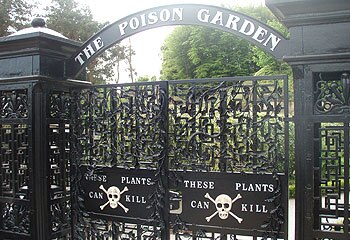Magical times at Harry Potter castle
FROM its toxic plants to secret gardens, Britain's Alnwick Castle is a magical adventure for all ages, writes Brad Crouch from the famous Harry Potter film set.

ALNWICK'S stunning gardens are a killer - literally.
In centuries past the gardens next to magnificent Alnwick Castle - the setting for two Harry Potter films - near Newcastle, Northumberland, had been a showpiece.
But thanks to the distractions of two World Wars they fell into neglect and were being eyed as a car park for the quaint local village.
In 1996 the energetic present Duchess of Northumberland decided to rescue them.
From the derelict, weed-infested mess has sprouted Alnwick Garden with ornamental gardens, mazes, the biggest water cascade in Britain, water jets for children, secret gardens, a woodland walk, plans for an adventure playground and a frozen pond.
It even has the biggest tree house in the world. But one of the most intriguing drawcards to the 20ha complex is the Poison Garden.
Visitors can only enter the fencedoff compound with a guide, for one very good reason. Walk through gates ominously marked "These Plants Can Kill" and you enter a world more suited to Poison Ivy than Mary Mary Quite Contrary.
Hemlock, Belladonna, Deadly Nightshade, Monk's Hood, Wormwood, Granny's Bonnet ... there are about 90 dangerous species, each with a gruesome tale to tell.
Some were used in famous murders, others to drive people mad, cause miscarriages or generally wreck havoc.
Guides happily tell stories such as how Socrates suicided by taking hemlock, but it took 12 hours to paralyse and kill him. Or how armies of bygone days used Monk's Hood to poison enemy's water wells in ancient chemical warfare.
The scary thing is, most of the plants look quite inoffensive, many are quite attractive, and some look quite familiar.
Like poisonous oleandar, found in many Australian gardens; catmint, which executioners used to take to make them aggressive; or yew trees, which can cause all sorts of sensory problems.
The garden also has opium poppies and cannabis plants in cages, thanks to a special licence, which makes a great talking point for adults and the basis for a drug education talk for children.
Children are big fans of Alnwick Garden thanks to the mazes, water jets, secret gardens and more.
The gardens opened in 2002 with hopes of attracting 50,000 visitors a year - it's been a runaway success with visitors of all ages and now pulls in more than 500,000 people a year to enjoy its colours, aromas, secret spots and general flora fun.
The water cascade puts on a different pattern every half hour, and the complex has a large cafe, art gallery and event space. About $100 million has been spent on it and organisers hope to raise a similar amount for future plans.
A short walk away, Alnwick Castle dominates the landscape.
It has been the backdrop for several movies - remember the scenes in Harry Potter where Hogwarts' students learn to ride broomsticks and play Quidditch?
The castle dates to the 11th century, when it was a walled town, protecting residents from marauders and invading Scots. Today it is Britain's second largest inhabited castle (after Windsor).
You enter through the massive outside walls topped by statues, to find protected inner lawns and outbuildings leading to a functioning palace complete with dungeons.
It has been home to the Percy family for 700 years, and the 4th Duke of Northumberland was so taken with Italian architecture he had the interior renovated to renaissance style with marble staircases, silk wall coverings, grand ceilings and the like.
While the exterior is austere, inside it is part art gallery, part museum and a fully working home.
Rather than frozen in time it remains the home of the 12th Duke of Northumberland and his family.
The state rooms are open to the public and, every so often when the family heads off to their London digs, visitors can wander through other parts of the grand home - the huge dining room, the library of 14,000 books and drawing rooms.
The rooms speak of a different era. The deep, intricate window frames in one ornate room each took one artisan a year to carve.
While the grand furniture, massive mirrors, delicate porcelain and more are jaw-dropping, part of the interest is in the modern family photos near suits of armour and ancient portraits.
One of the Duke and Duchess' daughters is a motorbike mechanic while another is a professional tennis player, and there are plenty of smiling photos of the girls among the antiques and works of art.
They give the castle/palace a distinctly modern and homely feel, speaking of warm family rather than cold ghosts.
The Duke's home truly is his castle.
It also is the heart of a 60,000ha agriculture business and younger visitors can try fun games such as Knights' Quest or Dragons' Quest.
The castle has a nice restaurant, while the nearby medieval market village has narrow streets full of character shops and quaint pubs like the White Swan or Oddfellows.
Alnwick genuinely is a fascinating place. Just don't pinch any flowers.
The writer travelled to Alnwick courtesy of Cathay Pacific Airways and VisitBritain
Sunday Mail (SA)


